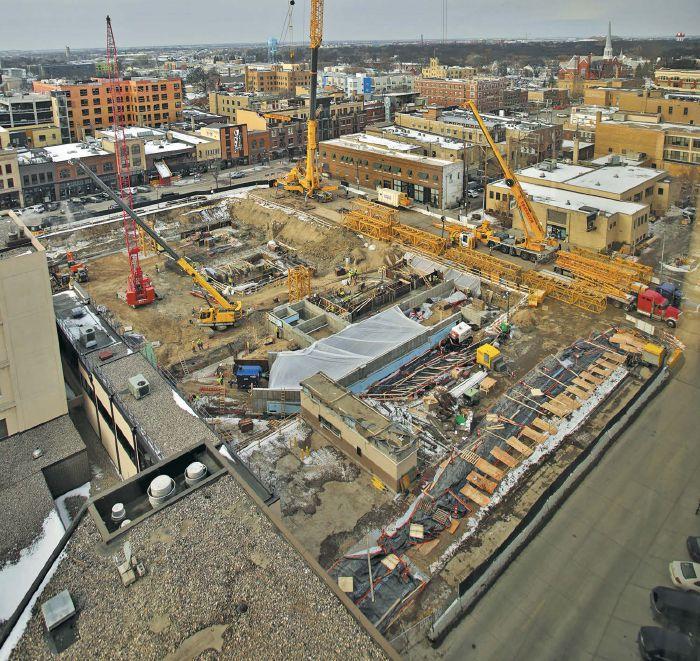
4 minute read
BEFORE
A 900-ton crane towers over downtown Fargo on Tuesday, Dec. 4, 2018, at the Block 9 tower construction site. The crane is the largest mobile crane in the upper Midwest. It was used to set one of the tower cranes on the site.
David Samson/The Forum
afterWhen it’s completed, Fargo’s Block 9 project will feature “a mid-rise, mixed-use tower that will add to a vibrant city core and change the skyline of downtown Fargo,” the website Block9Fargo.com reports. In addition, a half-acre public space “is anticipated to become a gathering and celebration space for the region.”

ARTIST’S RENDITION: Skidmore, Owings & Merrill, project architect

MEETING ATTENDEES:
At our meeting at the Porter Creek Hardwood Grill in Fargo on Nov. 27, Prairie Business talked about Fargo’s future with the following guests:
AARON BECHER
VP of newspaper operations Forum Communications
ANNE BLACKHURST President
Minnesota State University Moorhead
DEAN BRESCIANI President
NDSU
BEN CARLSRUD President Network Center, Inc.
NICOLE CHRISTENSEN Chief Nursing Officer Essentia Health
WILLIAM CRAFT President Concordia College
SHAWN DOBBERSTEIN
Executive director Hector International Airport
ALAN DOSTERT President, CEO and architect EAPC Architects Engineers
CHAD FLANAGAN Partner and Fargo market supervisor
Eide Bailly
KEVIN HANSON
COO Gate City Bank
JESSE HELLAND Director of business development McGough Construction
TIM MAHONEY Mayor of Fargo
TAMMY MILLER
CEO, Border States Electric
MARK NISBET
North Dakota principal manager, Xcel Energy Board chair, Fargo Moorhead West Fargo Chamber of Commerce
MARK STRAND
VP/Senior Trust Officer and East Region manager
First International Bank & Trust
DAVE VIG
Production principal Obermiller Nelson Engineering (ONE)


CONTINUED FROM: Page
Downtown Renaissance
The other asset that was highlighted time and again at the meeting was Fargo’s downtown. “We have 2,600 employee-owners across 22 states,” said Tammy Miller, Border States Electric CEO.
“So, at our corporate office here in Fargo, we are always recruiting. And it’s getting increasingly easier to attract top talent here.”
The downtown’s health is one big reason, Miller said.
In a 2014 column in Forbes magazine, California author Joel Kotkin described Fargo’s bad old days: “Twenty years ago, when I first visited the city, downtown was torpid on a good day,” Kotkin wrote.
“Storefronts were old, funky and often empty. The local hotels ranged between acceptable to sorry.”
Today, “the feel has certainly changed,” Kotkin concluded, and Miller of Border States Electric agreed.
“We had four people from Texas; they stayed in downtown, they went out at night to downtown. And they just could not believe it: there is such an amazing vibe and so many young people in the downtown.”
Asked what prompted the turnaround, attendees pointed to key events. One was NDSU’s decision in 2000 to move certain departments to a historic downtown building – a building that had been donated to the university’s foundation by Doug Burgum, now governor of North Dakota.
“I’ve worked downtown since 1982, and I think NDSU’s coming downtown was the turning point,” said Kevin Hanson, COO of Gate City Bank.
“I remember going out to dinner, and after 5, it would be a ghost town. Since NDSU came downtown, it’s a totally different culture. That was a major change.”
Another event was the passage of Renaissance Zone legislation by North Dakota lawmakers in 1999. The law exempts qualified projects from local property and state income taxes for five years.
“On the state level, we’re often dissing incentives, but that was an incentive that worked,” said Mark Nisbet, North Dakota principal manager for Xcel Energy and board chair of the Fargo Moorhead West Fargo Chamber of Commerce.
“The city never went backwards on its taxes. Instead, it just abated taxes while those improvements were being made, and now it has a higher tax base. It’s a good example of how incentives can work.”
Challenges Remain
As for challenges facing the F-M area, “workforce comes up consistently at the Chamber,” Nisbet said. “It keeps rising to the top of the list.”
Nicole Christensen, chief nursing officer at Essentia Health, agreed. Notably, though, the shortages are not uniform: “We see good ability to recruit individuals out of our university system,” Christensen said.
“But we also see a challenge with individuals after their first year of employment. That’s when we see them moving out of our community.”
Typically, nurses and other health care providers at that stage in their careers depart for the Twin Cities, where salaries are higher. Which brings up a longstanding problem that lawmakers should be reminded of: Medicare still pays less to North Dakota providers, as Essentia – which has facilities in both Minnesota and North Dakota, as well as Wisconsin and Idaho – knows first-hand.
So, Essentia’s facilities in Detroit Lakes, Minn., get paid more for for the same services than does Essentia Health-Fargo. “So that’s a challenge for us and for North Dakota,” Christensen said.
Housing is another issue. Young people have a tough time finding starter homes that they can afford; likewise, older people from rural North Dakota also are priced out when they try to move closer to their grandchildren. Smaller lots, smaller houses and smaller apartments are starting to be the result, Mahoney said.
Then there’s the challenge of finding day care services that are both high quality and affordable. Expect the Chamber to engage more directly with that issue in months to come, Nisbet said.
The Buzz
All things considered, though, Fargo’s in a great spot.
EAPC Architects Engineers recruits talent for its offices across Minnesota and North Dakota, among other states. “And we get people for Fargo right away,” said Alan Dostert, president and CEO.



For some other communities, “it can be more of a struggle.”
What’s Fargo’s advantage?
“I think it’s an energy thing,” he said. “There’s an energy in Fargo, and it’s an easy recruit because of that. Fargo just has a buzz to it, and people are really interested in what’s happening here.”
Tom Dennis
Editor, Prairie Business 701-780-1276 tdennis@prairiebusinessmagazine.com












